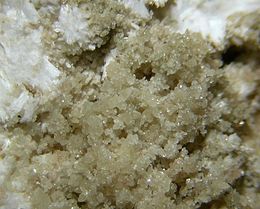Boehmite
| Boehmite | |
|---|---|
 Böhmite andNatrolitefrom Sagåsen (Strandåsen), Mørje, Porsgrunn, Telemark, Norway (Field of view 10 mm) | |
| General | |
| Category | Oxide mineral |
| Formula (repeating unit) | γ-AlO(OH) |
| IMA symbol | Bhm[1] |
| Strunz classification | 4.FE.15 |
| Dana classification | 6.1.2.1 |
| Crystal system | Orthorhombic |
| Crystal class | Dipyramidal (mmm) H-M symbol:(2/m 2/m 2/m) |
| Space group | Amam |
| Unit cell | a = 3.693Å, b = 12.221 Å, c = 2.865 Å; Z = 4 |
| Identification | |
| Color | White, pale greyish brown; yellowish or reddish when impure; colorless in thin section |
| Crystal habit | Tabular crystal rare, fine grained in pisolitic aggregates or disseminated |
| Cleavage | Very good on {010}, good on {100}, and poor on {001} |
| Fracture | Uneven |
| Tenacity | Brittle |
| Mohs scalehardness | 3.5 |
| Luster | Vitreous, pearly on {010} |
| Streak | White |
| Diaphaneity | Translucent |
| Specific gravity | 3.02–3.05 |
| Optical properties | Biaxial (+) |
| Refractive index | nα= 1.644 – 1.648 nβ= 1.654 – 1.657 nγ= 1.661 – 1.668 |
| Birefringence | δ = 0.017 – 0.020 |
| 2V angle | Measured: 74° to 88°, Calculated: 80° |
| Dispersion | weak |
| References | [2][3][4][5] |
Boehmiteorböhmiteis analuminium oxide hydroxide(γ-AlO(OH)) mineral, a component of thealuminiumorebauxite.It isdimorphouswithdiaspore.It crystallizes in theorthorhombicdipyramidal system and is typically massive in habit. It is white with tints of yellow, green, brown or red due to impurities. It has a vitreous to pearly luster, aMohs hardnessof 3 to 3.5 and aspecific gravityof 3.00 to 3.07. It is colorless in thin section, optically biaxial positive withrefractive indicesof nα = 1.644 – 1.648, nβ = 1.654 – 1.657 and nγ = 1.661 – 1.668.
Boehmite occurs in tropicallateritesand bauxites developed onalumino-silicatebedrock. It also occurs as ahydrothermal alterationproduct ofcorundumandnepheline.It occurs withkaolinite,gibbsiteand diaspore in bauxite deposits; and with nepheline, gibbsite, diaspore,natroliteandanalcimein nephelinepegmatites.[4]Industrially, it is used as an inexpensiveflame retardantadditive forfire-safe polymers.
It was first described by J. de Lapparent in 1927 for an occurrence in the bauxites of Mas Rouge,Les Baux-de-Provence,France,and named[6]for the Bohemian-German chemistJohann Böhm(1895–1952) who carried out X-ray studies of aluminium oxide hydroxides in 1925[7](and not for the German geologistJohannes Böhm(1857–1938) as often stated).[2][3]
See also[edit]
References[edit]
- ^Warr, L.N. (2021)."IMA–CNMNC approved mineral symbols".Mineralogical Magazine.85(3): 291–320.Bibcode:2021MinM...85..291W.doi:10.1180/mgm.2021.43.S2CID235729616.
- ^ab"Boehmite".Webmineral data.Retrieved2010-07-10.
- ^ab"Boehmite".Mindat with location data.Retrieved2010-07-10.
- ^abMineral Data Pub. Handbook of Mineralogy
- ^"The Mineral Boehmite".minerals.net.RetrievedJune 10,2014.
- ^Sahama, Th. G.; Lehtinen, Martti; Rehtijärvi, Pentti (1973). "Natural boehmite single crystals from Ceylon".Contributions to Mineralogy and Petrology.39(2): 171.Bibcode:1973CoMP...39..171S.doi:10.1007/BF00375738.S2CID129237343.
- ^Böhm, J. (1925). "Über Aluminium- und Eisenhydroxyde. I".Zeitschrift für anorganische und allgemeine Chemie.149:203–216.doi:10.1002/zaac.19251490114.
